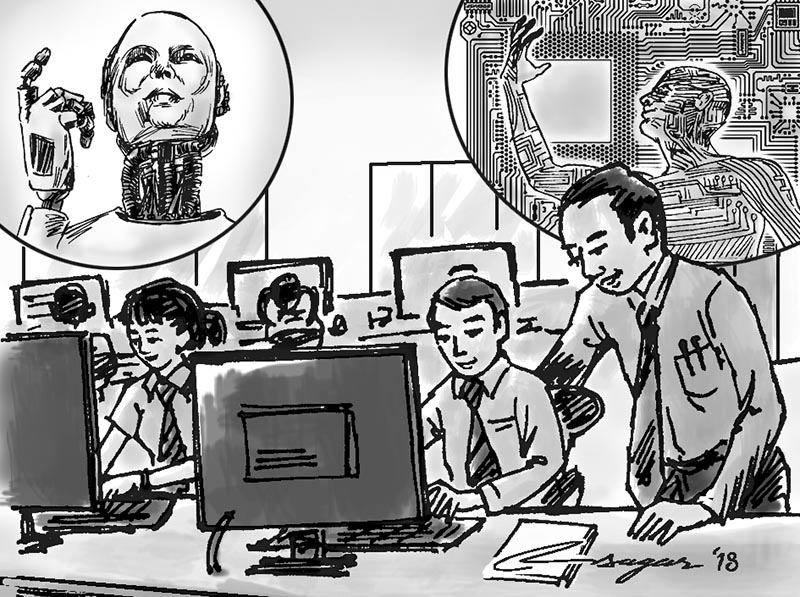AI tools in classroom: Making students smarter
By using different AI tools for different subjects in classrooms can make our students more creative, cognitive and productive, which ultimately make them more self-reliant and globally competitive citizens
Artificial intelligence (AI) is the computer-based exploration concerned with developing computer systems that can store knowledge and effectively use the knowledge in solving the problems. The task may include logical inference, diagnosis and visual recognition, comprehension of natural language, game playing, explanation, planning and so on. It is a branch of computer science and information technology. It mainly focuses on developing hardware and software systems that help to solve problems and accomplish the tasks.
The field of AI includes studying and developing machines such as robots, automatic pilots for airplanes, space ships, “smart” military weapons, etc. It is often called Machine Intelligence (MI).
In the early 1960s, Marvin Minsky indicated that “artificial intelligence is the science of making machines to do things that would require intelligence if done by men”.
In today’s competitive world, we need to prepare our students as global citizens for solving future global problems like climate change, endemic hunger and so on.
In Nepal, however, we aren’t preparing the next generation to meet the new challenges. Instead, we are mostly “preparing” labour forces for the foreign countries. Our education system hence must come up with a long-term plan to introduce AI in school curriculum.
As technology advances, educated workers tend to benefit more, and workers with less education tend to have their jobs automated. The educational goals of our country can be better achieved and managed if technology is introduced.
Our educational system has only given a great deal of emphasis on the linguistic and the logical/mathematics components of general intelligence. Less emphasis has been given on other aspects of general intelligence. In this connection, our educational system is just a combination of memorise, regurgitate and forget. This will take our future generation nowhere.
Using AI we can have better analysis of each and every student in a class. The analysis will give a clear idea about the student’s understanding on each and every topic. If a student is lagging in some areas or he/she is not able to understand some topics, AI analysis would show the report to teachers or parents so that appropriate action and corrective measures can be taken on time. This not only helps in bringing efficacy, but also helps students to become more productive and qualitative.
In a teaching and learning environment, students’ active participation along with lessons as well as the use of learning approaches help students remember what they have learnt. These dimensions can be realised through AI techniques.
AI techniques in education help to create powerful learning environments and increase positive interactive experiences for students. Some of the most typical AI applications in the educational field involve knowledge representation, intelligent tutoring, natural language processing, autonomous agents etc.
The effective learning approaches increase the quality of learning. Students learn best by doing and experiencing. To be effective and efficient, teaching programmes need to be student-centred rather than teacher-centred and must be based on research and investigation. They must include different experimental activities.
Each student has different learning ability. The topic explained by a teacher can be understood by students with one example in one go or it might take some time for others to understand the same topic even after multiple examples. This type of problem can be solved by using AI tools in a class, as it can help teachers to provide better materials or use better methods of learning to help students improve their performance in those problematic areas.
AI tools have capabilities in analysing multiple sources of data and comparing them to known patterns. This can identify the root causes for problems, and also drive the teaching-learning activity towards more consistent outcomes across different classes.
Mathematical skills are essential to almost all students and mathematics is a subject where many students find various difficulties. During the latest years, methods and techniques of AI were developed to assess the mathematical skill level of students and help them acquire specifics skills. Melis and his team developed and introduced ActiveMath, a web-based intelligent tutoring system for mathematics. ActiveMath is an Intelligence Tutoring System (ITS), which allows students to learn in their own environment whenever it is convenient for them. It uses a number of AI techniques to realise adaptive course generation, student modelling, feedback, interactive exercises and knowledge representation.
In a similar way, we can use different AI tools for different subjects and make our students more creative, cognitive and productive so that they become more self-reliant in finding answers various problems they encounter.
Introduction of AI in classrooms might be a big game changer in present education system. Therefore, AI is much more needed to develop cognitive skills, interpersonal skills, and intrapersonal skills in students to become globally competent citizens.
Joshi is faculty member at Patan Multiple Campus






